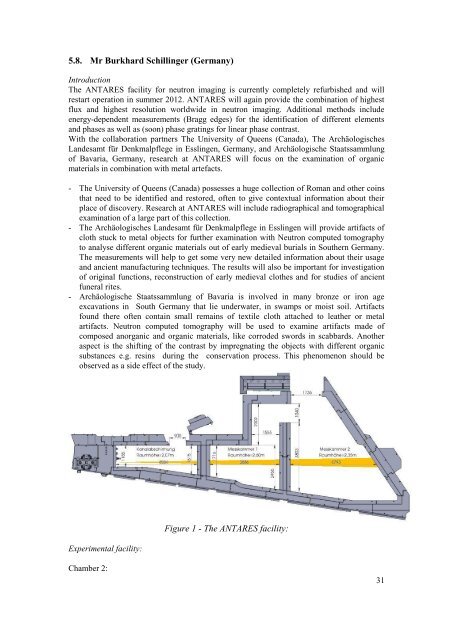Meeting report (pdf) - Nuclear Sciences and Applications - IAEA
Meeting report (pdf) - Nuclear Sciences and Applications - IAEA
Meeting report (pdf) - Nuclear Sciences and Applications - IAEA
You also want an ePaper? Increase the reach of your titles
YUMPU automatically turns print PDFs into web optimized ePapers that Google loves.
5.8. Mr Burkhard Schillinger (Germany)<br />
Introduction<br />
The ANTARES facility for neutron imaging is currently completely refurbished <strong>and</strong> will<br />
restart operation in summer 2012. ANTARES will again provide the combination of highest<br />
flux <strong>and</strong> highest resolution worldwide in neutron imaging. Additional methods include<br />
energy-dependent measurements (Bragg edges) for the identification of different elements<br />
<strong>and</strong> phases as well as (soon) phase gratings for linear phase contrast.<br />
With the collaboration partners The University of Queens (Canada), The Archäologisches<br />
L<strong>and</strong>esamt für Denkmalpflege in Esslingen, Germany, <strong>and</strong> Archäologische Staatssammlung<br />
of Bavaria, Germany, research at ANTARES will focus on the examination of organic<br />
materials in combination with metal artefacts.<br />
- The University of Queens (Canada) possesses a huge collection of Roman <strong>and</strong> other coins<br />
that need to be identified <strong>and</strong> restored, often to give contextual information about their<br />
place of discovery. Research at ANTARES will include radiographical <strong>and</strong> tomographical<br />
examination of a large part of this collection.<br />
- The Archäologisches L<strong>and</strong>esamt für Denkmalpflege in Esslingen will provide artifacts of<br />
cloth stuck to metal objects for further examination with Neutron computed tomography<br />
to analyse different organic materials out of early medieval burials in Southern Germany.<br />
The measurements will help to get some very new detailed information about their usage<br />
<strong>and</strong> ancient manufacturing techniques. The results will also be important for investigation<br />
of original functions, reconstruction of early medieval clothes <strong>and</strong> for studies of ancient<br />
funeral rites.<br />
- Archäologische Staatssammlung of Bavaria is involved in many bronze or iron age<br />
excavations in South Germany that lie underwater, in swamps or moist soil. Artifacts<br />
found there often contain small remains of textile cloth attached to leather or metal<br />
artifacts. Neutron computed tomography will be used to examine artifacts made of<br />
composed anorganic <strong>and</strong> organic materials, like corroded swords in scabbards. Another<br />
aspect is the shifting of the contrast by impregnating the objects with different organic<br />
substances e.g. resins during the conservation process. This phenomenon should be<br />
observed as a side effect of the study.<br />
Experimental facility:<br />
Chamber 2:<br />
Figure 1 - The ANTARES facility:<br />
31
















